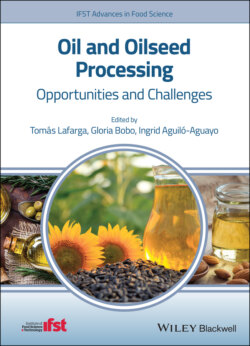Читать книгу Oil and Oilseed Processing - Ingrid Aguilo-Aguayo - Страница 22
1.2.8 Rapeseed and Canola Oil
ОглавлениеThe genus Brassica, which is the most important within the Brassicaceae family, includes the six interrelated species Brassica nigra, Brassica oleracea, Brassica rapa, Brassica carinata, Brassica juncea, and Brassica napus (Cartea et al. 2016). Both rapeseed and canola belong to the Brassicaceae family. In some countries, the term rapeseed oil refers to the oils for industrial use, while canola oil is used to refer to the edible cooking oil. Canola is a subgroup within the rapeseeds and include those Brassica species having seeds containing oil with under 2% erucic acid and low levels of glucosinolates. As an estimate, Daun (2015) recently suggested that, to identify the amount of rapeseed crops that are canola quality, a good estimate can be obtained by assuming that all production in North America, Australia, Scandinavia, and Western Europe is canola quality, while only 10 and 75% of the production in China and Eastern Europe are canola. In the current chapter, all Brassica seeds utilized for oil production will be referred to as rapeseeds. Currently, rapeseeds rank second in world production of oilseeds (third if considering palm oil). According to data accessed from the USDA, world production of rapeseed during 2018/2019 was 70.37 Mt (USDA 2019a). Production of rapeseed in the EU increased from 19.02 Mt in 2009 to 19.80 Mt in 2018, with a historical maximum production of 24.26 Mt in 2014 (European Commission 2019). Rapeseed has a long history of use in Europe, Scandinavia, China, and India and has been more recently introduced into Canada and Australia (Daun 2015). Rapeseeds are adapted to the cool extremes of the temperature zones: although the optimum growth temperature is around 10 °C, minimum temperatures for growth have been reported to be near 0 °C (Daun 2015). Major rapeseed growing areas, shown in Figure 1.1, include temperate areas of Europe, Asia, and to a lesser extent, North America. Indeed, 41.5 and 39.3% of the total rapeseed oil production was carried out in Europe and Asia, respectively (Figure 1.4). Rapeseed oil was ninth most produced commodity within the “processed crops” classification of FAOSTAT, and the third most produced oil only surpassed by palm oil and soybean oil, which ranked fourth and sixth, respectively.
In the EU‐28 the area harvested increased from 6.17 Mha in 2008 to 6.96 Mha in 2018 (European Commission 2019). As shown in Figure 1.4, biggest producers in 2017 were China, Germany, and Canada (UN 2019). Canada is currently the major rapeseed oil exporter. Indeed, according to data obtained from FAOSTAT, 2.93 Mt of rapeseed oil were exported during 2017 (UN 2019). Although there will continue to be a market for rapeseed oil, mainly for industrial processes because of its high heat stability and for specialty foods, the world trend is to increase the production of canola‐quality seeds (Daun 2015). Global rapeseed production is forecast to rise 3.9 Mt on the strength of a 9% increase in are harvested and an increased production in Canada, Ukraine, India, the EU, and the US (USDA 2017).
